
Wire Torsion Testing Machine
During the armoring process and subsequently during laying of the cable, the armor wires are subjected to torsion stress. The test is conducted to evaluate the torsion resistance of the wire. A Unique Machine which conforms to three different test standards. The machine is manufactured as per IS 10810 Pt 38 (Torsion Test On Galvanized Steel Wires For Armoring.), IS 10810 Pt 39 (Winding Test On Galvanized steel Strips For Armoring.) and IS 10810 Pt 3 (Wrapping Test For Aluminum Wires). for wire.
Power : 1 KW
Voltage : 220 V 50 Hz
...more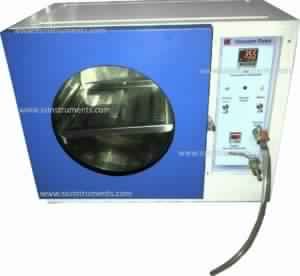
Vacuum Oven with Digital Vacuum Controller
Model Number: SSI 558 VOC Standard Number: IS: 10810 (Pt.33) SSIPL vacuum ovens are required in almost every institution for drying, moisture removal by heating in vacuumed environment. SSI 107 Vacuum Oven is a double walled leak proof chamber with inner chamber made of Stainless steel and outer chamber of Mild Steel powder coated. The Heaters are embedded, and are controlled by digital temperature controller for temperature range from 50 to 150 deg C. Vacuum range 0-30 PSI is achieved by a separate vacuum pump connected to the oven using rubber pipe. A toughened glass window is provided in the door to view the samples inside without disturbing the thermal / vacuum conditions A choice of cylindrical / rectangular inner chamber is available as per requirement. Some of the standard sizes are Cylindrical Rectangular Diameter X Depth L X B X H 250 X 300 mm 6” X 6” X 6” 300 X 300 mm 8” X 8” X 8” 10” X 10” X 10” 12” X 12” X 12” Vacuum Ovens with temperature up to 300°C with Stainless steel door / Digital vacuum control with solenoid valves are also available on request.
...more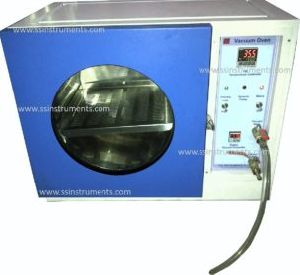
Digital Controller Vacuum Oven
SSIPL vacuum ovens are required in almost every institution for drying, moisture removal by heating in vacuumed environment.
...more
Ultra Low Cold Chambers
Model Number: SSI 506 UL When the Cables / Electrical Equipments are subjected top extreme cold for a considerable duration of time, they may become hardened and stiff. Such hardness and stiffness cause cracking of the insulation or sheath and may lead to failure of cable / equipments. Description When the Cables / Electrical Equipments are subjected top extreme cold for a considerable duration of time, they may become hardened and stiff. Such hardness and stiffness cause cracking of the insulation or sheath and may lead to failure of cable / equipments. The extent and type of change that takes place depends upon the severity of exposure of the sample to cold temperatures. This test makes an assessment of change in equipment performance by subjecting them to accelerated ageing in very low temperature. The instrument is available in two various different models with temperature range for -0 to -86oC. The instrument consists of Cold Chamber Size (as per requirement of customer) Digital Temperature Indicating controller Glass Window on the door. (if required) Very high displacement compressor of about 22 per revolution Highly efficient refrigerant R404A having a boiling pt. Of -46DegC Our freezer does not require a low ambient temp. It can work even at an ambient of 40DegC We use a down feed evaporator so as to improve the refrigeration effect and coeff. Of performance of the system as a whole High density PUF of about 60kg/cm3 so as to hold the temperature for a longer time Hot discharge is circulated on the mouth of the freezer to prevent cooling losses Microprocessor based temperature controller for accurate temperature and longer compressor life. Standard compressor of 1 hp Cascading Refigration System Copper Capillary of higher wall thickness to last longer Uniform capillary distribution on the surface of chamber for better / faster and uniform cooling within chamber. Double door formation (acrylic + normal) for better insulation Noise less operations
...more
Ultra Low Temperature Chambers
When the Cables / Electrical Equipments are subjected top extreme cold for a considerable duration of time, they may become hardened and stiff. Such hardness and stiffness cause cracking of the insulation or sheath and may lead to failure of cable / equipments.
Temperature Range : Models availabe in 0 up to -86oC
...more
Two Roll Mill (Variable Roller Speed)
Model Number: SSI 511 TRPVS Two Roll Mill is used for mixing two or more compounds in a homogeneous mixture. This Mixture is then molded into samples for further testing. Instrument Principle Uniform mixing of two or more components to make a homogeneous mixture is vital to make samples for testing. The Two Roll Mill with its two heated rollers, rotating in opposite directions, at slightly different speeds is an ideal machine for such a work. The final test samples can then be obtained from the sheet by using Hydraulic Hot Press, Dumb-bell Dies etc. Two Roll Mill is available in various models for specific customer requirement. Various Models are For PVC (With Heating only) For Rubber (with Water Cooling only) For PVC and Rubber (with heating and water cooling) Rollers with Variable RPM Rollers with Variable RPM and Friction Ratio Instrument The Instrument consists of following: Two rollers mounted on a sturdy frame, rotating in opposite opposite at slightly different speeds. Roller Size: 6″ dia, 12″ Length. Temperature Control : Using two Energy Regulators one for each roller. Heater: Heating by especially designed U shaped heaters. Motor: 3 Hp, 440 VAC, 3 phase. Gear Assembly : to drive the rollers in opposite directions. Control: Forward Reverse Switch and power cord. Spatula for mixing the compound. Emergency Switch to shut off motor in case of emergency This Model is suitable for PVC and allied material which require heating for melting and mixing. Not suitable for rubber materials which generates heat during mixing.
...more
Two Roll Mill (Fixed Roller Speed)
Model Number: SSI 511 TRPFS Two Roll Mill is used for mixing two or more compounds in a homogeneous mixture. This Mixture is then molded into samples for further testing. Instrument Principle For preparing test sample from two or more materials, they have to be mixed homogeneously. The Two Roll Mill with its two heated rollers, rotating in different directions, at slightly different speeds is an ideal machine for such a work. The test samples can then be obtained from the sheet by using Hydraulic Hot Press, Dumb-bell Dies etc. Two Roll Mill is available in various models for specific customer requirement. Various Models are For PVC (With Heating only) For Rubber (with Water Cooling only) For PVC and Rubber (with heating and water cooling) Rollers with Variable RPM Rollers with Variable RPM and Friction Ration Instrument The Instrument consists of following: Two rollers mounted on a sturdy frame, rotating in different direction at slightly different speeds. Roller Size: 6 dia, 12 Length. Two energy regulator for heating control one for each roller. Heating by especially designed U shaped heaters. One 440 V III phase motor with gear assembly for rotating the rollers. Start / Stop switch and power cord. Two Emergency Switches, one on panel and one on knee height to reverse the motor in case of any emergency. Guard plates and funnel on rollers to prevent accidental insertion of operator hand between rollers. Spatula for mixing the compound.
...more
Two Roll Mill Digital Temperature Controller
Model Number: SSI 511 TRPFSD Two Roll Mill is used for mixing two or more compounds in a homogeneous mixture. This Mixture is then molded into samples for further testing. Instrument Principle For preparing test sample from two or more materials, they have to be mixed homogeneously. The Two Roll Mill with its two heated rollers, rotating in different directions, at slightly different speeds is an ideal machine for such a work. The test samples can then be obtained from the sheet by using Hydraulic Hot Press, Dumb-bell Dies etc. Two Roll Mill is available in various models for specific customer requirement. Various Models are For PVC (With Heating only) For Rubber (with Water Cooling only) For PVC and Rubber (with heating and water cooling) Rollers with Variable RPM Rollers with Variable RPM and Friction Ration Instrument The Instrument consists of following: Two rollers mounted on a sturdy frame, rotating in different direction at slightly different speeds. Roller Size: 6 dia, 12 Length. Two PID Controller for heating control one for each roller. Heating by especially designed U shaped heaters. One 440 V III phase motor with gear assembly for rotating the rollers. Start / Stop switch and power cord. Two Emergency Switches, one on panel and one on knee height to reverse the motor in case of any emergency. Guard plates and funnel on rollers to prevent accidental insertion of operator hand between rollers. Spatula for mixing the compound.
...more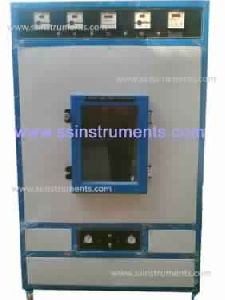
toxicity test apparatus
Model Number: SSI 558 Standard Number: NCD 1409 Any compound when burned emits a cocktail of gases, which are harmful to humans. The significant of these gases is increased if the area under fire is compact and can have serious effects on humans and other material present in the room. Any compound when burned emits a cocktail of gases, which are harmful to humans. The significant of these gases is increased if the area under fire is compact. This test determines the amount of various toxic gases emitted during the burning of various material . The Sample is burned under test conditions by open flame of 1200o C temperature. All the gases thus emitted are collected and analyzed for their composition and concentrations using Gas detection tube. The instrument Consist of Double Walled Chamber Inner Chamber of Polypropylene Polymer sheet of 8mm thickness, outer of MS powder coated. Burner capable of producing 1200 deg C flame Timers of Flame application (with buzzer), Mixing Fan, Exhaust fan Temperature Indicator for Flame , Chamber Safety measures for Flame outage / excess pressure in chamber SS sample stand with titanium alloy mesh Toughed glass window Single port for insertion of Gas detection tube. (Tube / pump does not form the part of this instrument)
...more
Torsion Testing Machine
Model Number: SSI 523 Standard Number: IS 10810 Pt 38IS 10810 Pt 39IS 10810 Pt 3 During the armoring process and subsequently during laying of the cable, the armor wires are subjected to torsion stress. The test is conducted to evaluate the torsion resistance of the wire. A Unique Machine which conforms to three different test standards. The machine is manufactured as per IS 10810 Pt 38 (Torsion Test On Galvanized Steel Wires For Armoring.), IS 10810 Pt 39 (Winding Test On Galvanized steel Strips For Armoring.) and IS 10810 Pt 3 (Wrapping Test For Aluminum Wires). for wire. During the armoring process and subsequently during laying of the cable, the armor wires are subjected to torsion stress. The test is conducted to evaluate the torsion resistance of the wire. The wire is attached between the two vices and twisted / turned. The no of turns required to break the wire is then noted. The Instrument consists of following: Two Vices. Heavy Duty Motor Weight attachment to provide tension to sample Attachment for Winding and wrapping Test complete with weight and Mandrels
...more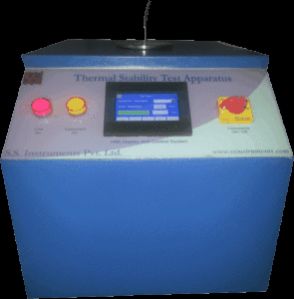
Thermal Stability Test (HMI Model)
Model Number: SSI 501 TSH Standard Number: IS: 5831, IS:10810 Pt 60, IEC: 540 Thermoplastics and PVC materials when exposed to continuous heat, degenerates and emit harmful acidic gases. The instrument is manufactured for testing PVC materials against their thermal stability at higher temperature. Principle Thermoplastics and PVC materials when exposed to continuous heat, degenerates and emit harmful acidic gases. The instrument is manufactured for testing PVC materials against their thermal stability at higher temperature. The basic principal is that the pH paper changes its color when it comes in contact with halogen gases, released by PVC and its compounds on heating at higher temperatures. Standards The Instrument is especially designed to suit the requirement of IS: 5831, IS 10810 (Pt 60), IEC 540 Instrument The instrument consists of One solid Aluminum block used as the heating medium. 16 holes are drilled in the aluminum block for keeping the sample. Specially designed embedded / Jacket heaters in the thermal block. Digital Temperature Indicating Controller for precise setting & control of temperature. Touch Screen HMI to control and Display the parameters of the Test Consumables like ph paper & test tubes are not part of the standard equipment and are available at extra cost. The sample is put inside a glass test tube and the test tube is dipped into the per heated Thermal Block. A small piece of ph paper is attached to the test tube. The time of insertion of tube is noted down. As the PVC disintegrates, it release acidic fumes which changes the color of ph paper. The time of change of color is again noted down. Using these times, the thermal stability time is determined for the PVC sample.
Temperature : : Ambient to 225oC, LC 0.1oC
...more
Thermal Stability Test Apparatus for PVC
Model Number: SSI 501 TS Standard Number: IS: 5831, IS: 10810 (Pt.60), IEC:540 Thermoplastics and PVC (Plasticized Polyvinyl Chloride) materials when exposed to continuous heat, degenerates and emit harmful acidic gases. The instrument is manufactured for testing PVC materials against their thermal stability at higher temperature. Instrument Principle Thermoplastics and PVC materials when exposed to continuous heat, degenerates and emit harmful acidic gases. The instrument is manufactured for testing PVC materials against their thermal stability at higher temperature. The basic principal is that the pH paper changes its color when it comes in contact with halogen gases, released by PVC and its compounds on heating at higher temperatures. Standards The Instrument is especially designed to suit the requirement of IS: 5831, IS 10810 (Pt 60), IEC 540 Instrument The instrument consists of One solid Aluminum block used as the heating medium. 15 holes are drilled in the aluminum block for keeping the sample. Specially designed embedded / Jacket heaters in the thermal block. Digital Temperature Indicating Controller for precise setting & control of temperature. Consumables like ph paper & test tubes are not part of the standard equipment and are available at extra cost. A stop watch has to be provided by the user. The sample is put inside a glass test tube and the test tube is dipped into the per heated Thermal Block. A small piece of ph paper is attached to the test tube. The time of insertion of tube is noted down. As the PVC disintegrates, it release acidic fumes which changes the color of ph paper. The time of change of color is again noted down. Using these times, the thermal stability time is determined for the PVC sample
Temperature : : Ambient to 225oC, LC 0.1oC
...more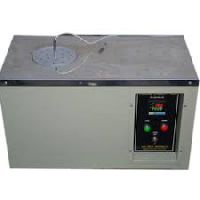
Thermal Stability Test Apparatus
Thermoplastics and PVC (Plasticized Polyvinyl Chloride) materials when exposed to continuous heat, degenerates and emit harmful acidic gases. The instrument is manufactured for testing PVC materials against their thermal stability at higher temperature.Thermoplastics and PVC materials when exposed to continuous heat, degenerates and emit harmful acidic gases. The instrument is manufactured for testing PVC materials against their thermal stability at higher temperature. The basic principal is that the pH paper changes its color when it comes in contact with halogen gases, released by PVC and its compounds on heating at higher temperatures.
...more
Thermal Stability Test
Thermoplastics and PVC materials when exposed to continuous heat, degenerates and emit harmful acidic gases. The instrument is manufactured for testing PVC materials against their thermal stability at higher temperature.
Temperature : Ambient to 225oC, LC 0.1oC
...more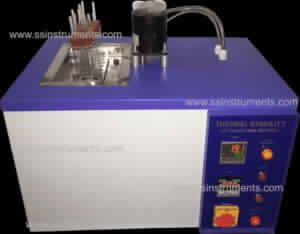
Thermal Stability instrument
Model Number: SSI TSOB Standard Number: IS: 4669 Thermoplastics and PVC (Plasticized Polyvinyl Chloride) materials when exposed to continuous heat, degenerates and emit harmful acidic gases. The instrument is manufactured for testing PVC materials against their thermal stability at higher temperature. Principle Thermoplastics and PVC materials when exposed to continuous heat, degenerates and emit harmful acidic gases. The instrument is manufactured for testing PVC materials against their thermal stability at higher temperature. The basic principal is that the Congo Red paper changes its color when it comes in contact with halogen gases, released by PVC and its compounds on heating at higher temperatures. Standards The Instrument is especially designed to suit the requirement of IS: 4669 Instrument The instrument consists of One oil bath to heat the oil for wet heating. 10 Glass Test Tubes (16 mm dia). 10 Glass test tubes (2 mm dia). Digital Temperature Indicating Controller for precise setting & control of temperature. Stirrer for uniform Temperature throughout the oil bath Consumables like Congo Red paper & test tubes are not part of the standard equipment and are available at extra cost. The sample is put inside a glass test tube and the test tube is dipped into the per heated oil bath. A small piece of ph paper is attached to a smaller test tube. The time of insertion of tube is noted down. As the PVC disintegrates, it release acidic fumes which changes the color of congo red paper. The time of change of color is again noted down. Using these times, the thermal stability time is determined for the PVC sample
Temperature : : Ambient to 225oC, LC 0.1oC
...more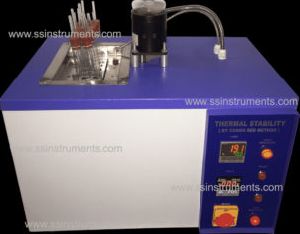
Thermal Stability
Thermoplastics and PVC (Plasticized Polyvinyl Chloride) materials when exposed to continuous heat, degenerates and emit harmful acidic gases. The instrument is manufactured for testing PVC materials against their thermal stability at higher temperature.
Temperature : Ambient to 225oC, LC 0.1oC
Delivery : 3 to 4 Weeks
...more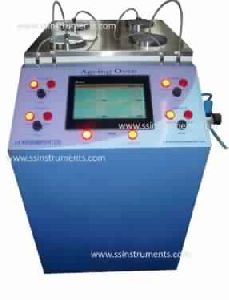
Thermal Ageing Oven as per IEC & IS (with HMI)
Model Number: SSI 502 AGIS HMI Standard Number: IS: 10810 Pt.10, IS: 10810 Pt. 11, IEC 60811-1-2 Thermoplastic and Poly vinyl Chloride substances when exposed to heat undergo many types of physical and chemical changes. The extent and type of change that takes place depends upon the severity of exposure of the sample to heat (i.e., temp. range), duration and rate of air flow. Instrument Principle Thermoplastic and Poly Vinyl Chloride substances when exposed to heat undergo many types of physical and chemical changes. The extent and type of change that takes place depends upon the severity of exposure of the sample to heat (i.e., temp. range), duration and rate of air flow. This test makes an assessment of change in Tensile Strength and Elongation of the material on subjecting them to accelerated ageing in hot air. Standards The Instrument is especially designed to suit the requirement of IEC: 60811-1-2, IS 10810 (Pt 10), IS 10810 (Pt 11) Instrument . Each Cell of Thermal Ageing Oven is a complete instrument in itself i.e., fitted with individual Temp. Indicating Controller, Air Flow Meter, Air temperature controller and an Hour Meter. This enables the user to test different type of samples at desired temperature and duration, depending upon test requirement of end users & testing authorities. The Thermal Ageing Oven instrument consists of the following: . A double walled chamber with inside chamber of thick aluminum sheet. Size of the chamber is 100 mm dia. x 300mm ht. Jacket type heater for the chamber. Digital Temp. Indicating Controller with sensor. Temp. range 0-200 ± 2 oC. Digital Flow Sensors with needle valves for controlling the volume of air passing through the chamber. Air inlet nozzle for the airline or air compressor. Specially designed split top cover to hold three to five test samples in each chamber. 7″ HMI to display and control the ageing Oven. Blind Thermostat to cut off heaters after 250oC in case of temperature overshoot for each chamber. . To operate the Thermal Ageing Oven unit Compressed Air line is to be provided by the customer. If the customer is using his own air compressor, it may require one pressure regulator, pressure gauge & connecting pipes which are available from us. Difference Between Hot Air Oven and Thermal Ageing Oven: The test requirement is 8 to 20 air changes per hour, measured on a Flow Meter. According to IS standard, if the Oven does not have a regulated air supply, the oven is then termed as a Hot Air Oven and not a Ageing Oven (as offered by some manufactures) and cannot be used for ageing of samples. After ageing in the ageing test oven for specified temp. & duration the samples are to be tested on Tensile Testing Machine for tensile & elongation. For preparation of Dumb-bell shaped samples, you may require hydraulic hot press, dumb-bell dies, dumb-bell cutting press, two-roll mill etc. Please ask for details.
...more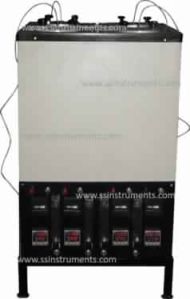
Thermal Ageing Oven as per IEC
Model Number: SSI 502 AGIS Standard Number: IS: 10810 Pt.10, IS: 10810 Pt. 11, IEC 60811-1-2 Thermoplastic and Poly vinyl Chloride substances when exposed to heat undergo many types of physical and chemical changes. The extent and type of change that takes place depends upon the severity of exposure of the sample to heat (i.e., temp. range), duration and rate of air flow. Instrument Principle Thermoplastic and Poly Vinyl Chloride substances when exposed to heat undergo many types of physical and chemical changes. The extent and type of change that takes place depends upon the severity of exposure of the sample to heat (i.e., temp. range), duration and rate of air flow. This test makes an assessment of change in Tensile Strength and Elongation of the material on subjecting them to accelerated ageing in hot air. Standards The Instrument is especially designed to suit the requirement of IEC: 60811-1-2, IS 10810 (Pt 10), IS 10810 (Pt 11) Instrument Each Cell of Thermal Ageing Oven is a complete instrument in itself i.e., fitted with individual Temp. Indicating Controller, Air Flow Meter, Air temperature controller and an Hour Meter. This enables the user to test different type of samples at desired temperature and duration, depending upon test requirement of end users & testing authorities. The Thermal Ageing Oven instrument consists of the following: . A double walled chamber with inside chamber of thick aluminum sheet. Size of the chamber is 100 mm dia. x 300mm ht. Jacket type heater for the chamber. Digital Temp. Indicating Controller with sensor. Temp. range 0-200 ± 2oC. Rotometer for controlling the volume of air passing through the chamber. Air inlet nozzle for the airline or air compressor. Specially designed split top cover to hold three to five test samples in each chamber. Hour Meter to record the total time of test. . To operate the Thermal Ageing Oven unit Compressed Air line is to be provided by the customer. If the customer is using his own air compressor, it may require one pressure regulator, pressure gauge & connecting pipes which are available from us. Difference Between Hot Air Oven and Thermal Ageing Oven: The test requirement is 8 to 20 air changes per hour, measured on a Flow Meter. According to IS standard, if the Oven does not have a regulated air supply, the oven is then termed as a Hot Air Oven and not a Ageing Oven (as offered by some manufactures) and cannot be used for ageing of samples. After ageing in the ageing test oven for specified temp. & duration the samples are to be tested on Tensile Testing Machine for tensile & elongation. For preparation of Dumb-bell shaped samples, you may require hydraulic hot press, dumb-bell dies, dumb-bell cutting press, two-roll mill etc. Please ask for details.
...more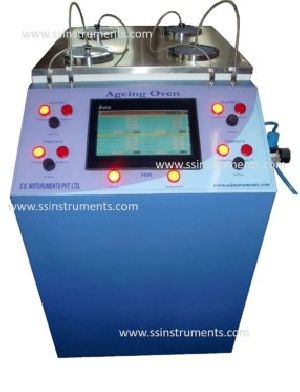
Thermal Ageing Oven
Thermoplastic and Poly vinyl Chloride substances when exposed to heat undergo many types of physical and chemical changes. The extent and type of change that takes place depends upon the severity of exposure of the sample to heat (i.e., temp. range), duration and rate of air flow.
...more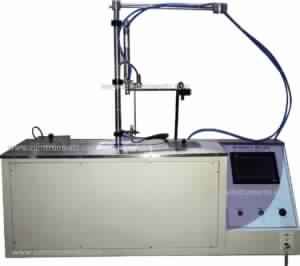
Solder Bath
model number: ssi 560 sbt standard number: iec 60245-2:1994 the test is intended to verify the effectiveness of the separator between the non tinned conductor and insulation. instrument principle the test is intended to verify the effectiveness of the separator between the non tinned conductor and the insulation. the instrument consist of one pickling bath and one solder bath. The solder bath is designed to maintain a temperature of up to 300oc, as to keep the solder in a molten state. the ample is first dipped in the pickling bath and then dipped in the solder bath for predetermined cycles. The no of dips and the speed of dip can be controlled. standard the instrument conforms to iec 60245-2 : 1994 instrument one pickling bath one solder bath an automated robotic arm to dip the sample in pickling and solder bath the arm is also designed to transfer the sample form pickling to solder bath plc to control the instrument. hmi for display and interacting with the operator.
Sold Bath Size : 4 x 4 x 4 (LBH in inches)
Temperature : up to 300oC
Sample Dipping Speed : 25 mm / sec
No of Dips : 0-9 programmable
...more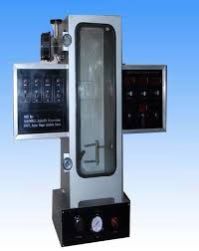
Smoke Density Tester
Smoke Density Apparatus is used for measuring & observing the relative amount (Density) of smoke produced by the burning (combustion) or decomposition of Plastic, Cables etc. under controlled conditions.Smoke Density Test Apparatus is used for measuring & observing the relative amount (Density) of smoke produced by the burning (combustion) or decomposition of Plastic, Cables etc. under controlled conditions.
...more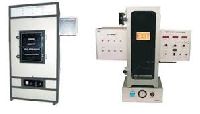
Smoke Density Test Apparatus
Smoke Density Apparatus is used for measuring & observing the relative amount (Density) of smoke produced by the burning (combustion) or decomposition of Plastic, Cables etc. under controlled conditions.
...more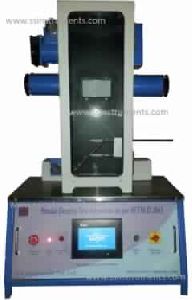
Smoke Density (ASTM) with HMI
Model Number: SSI 516 SDASH Standard Number: ASTM 2843, IS 13660 (Part 6/Sec9) Smoke Density Apparatus is used for measuring & observing the relative amount (Density) of smoke produced by the burning (combustion) or decomposition of Plastic, Cables etc. under controlled conditions. Instrument Principle Smoke Density Test Apparatus is used for measuring & observing the relative amount (Density) of smoke produced by the burning (combustion) or decomposition of Plastic, Cables etc. under controlled conditions. In Smoke Density Test Apparatus, the sample is burned under controlled pressure of LPG, through a specified burner as per the standard. A light source and a photo receptor is placed on either side of the chamber, and the percentage of light absorbed is displayed through a linear amplifier digital electronic photometer with 0 to 100% absorbance scale. The Smoke Density Test apparatus comes complete with timer with 1.5-second pulse at every 15 sec, with hold facility, gas pressure gauge, damper and exhaust fan for removing smoke from the chamber. Standard The instrument is manufactured as per the ASTM D 2843, IS 13360 (Part 6/ Sec 9) etc. Instrument The Smoke Density Test Apparatus instrument comprises of Single Walled glass door chamber made of 14 gauge Aluminum Burner, gas regular Electronic Photo-metric System Timer Specimen Holder Damper Exhaust fan The Sample is burned using ASTM specified burner under control conditions. A Light source (6 V DC Bulb) emits light which is captured by Photocell which converts the light into Voltage. The intensity of light is proportional to the voltage produced. This voltage is picked up by sophisticated electronic detector, which display the same as % Absorption. As the smoke fills the chamber, the light intensity is reduced, reducing the voltage and the % absorption increase. The instrument is controlled using a PLC. All the parameters including burner movement, timer, recording of absorption % etc are controlled using the PLC. The parameters are displayed on a 7″ touch screen HMI. The user can interacts with the instrument using this HMI. Operator and test parameters are feed in the PLC using the HMI only. The results are displayed on the HMI screen. The screen shots can be stored on the pen drive for future references.
...more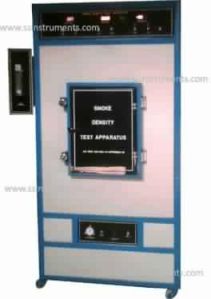
Smoke Density (as per UIC)
Model Number: SS 516 U Standard Number: UIC 564 Smoke Density Apparatus is used for measuring & observing the relative amount (Density) of smoke produced by the burning (combustion) or decomposition of Plastic, Cables etc. under controlled conditions. Instrument Principle Smoke Density Apparatus is used for measuring & observing the relative amount (Density) of smoke produced by the burning (combustion) or decomposition of Plastic, Cables etc. under controlled conditions. The sample is burned under controlled pressure of LPG, through a specified burner as per the standard. A light source and a photo receptor is placed on either side of the chamber, and the percentage of light absorbed is displayed through a linear amplifier digital electronic photometer with 0 to 100% absorbance / Transmission / lux scale. The apparatus comes complete with timer , gas pressure gauge, damper and exhaust fan for removing smoke from the chamber. Standard The instrument conforms to UIC 564 specification and also confirms various other international standards. Instrument The instrument comprising of A glass door chamber (internal size 750 x 750 x 1000 mm) Burner, gas regular Electronic Photometric System Timer Specimen Holder Damper Exhaust fan
...moreBe first to Rate
Rate ThisOpening Hours